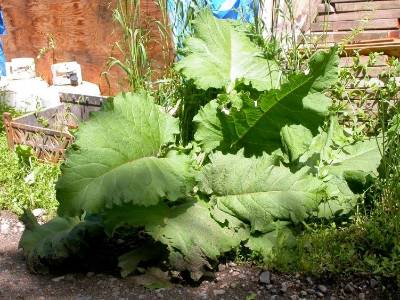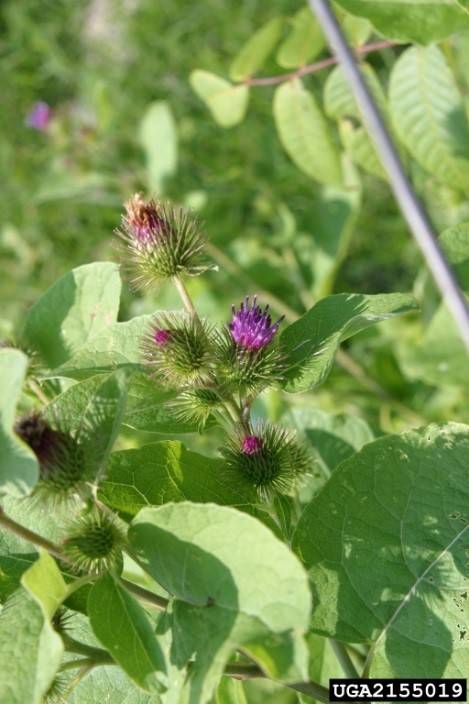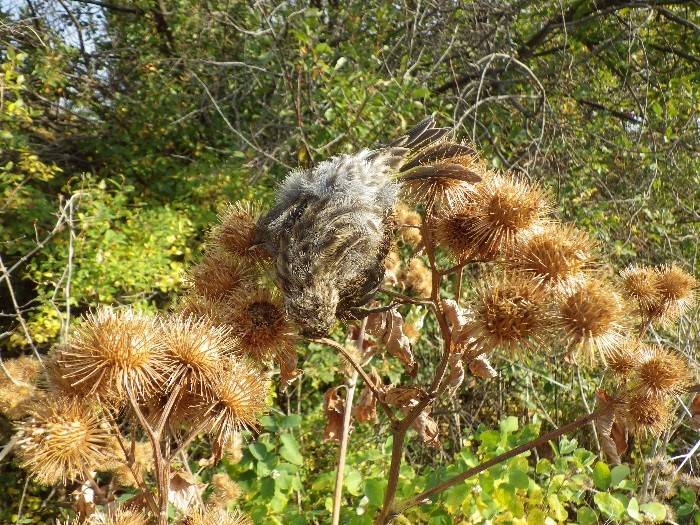Common burdock (Arctium minus)
Download weed post on Common burdocl (Arctium minus) as PDF (includes word puzzle)

Matt Lavin, MSU.
History and status
Common burdock, also known as lesser burdock or wild rhubarb, is native to Europe. After being accidently introduced to North America in the 1600’s, it has been reported in every U.S. state and Canadian province except Florida, Texas, and Hawaii. Common burdock has been reported in at least 29 counties in Montana and is on 10 Montana county noxious weed lists (Big Horn, Blaine, Carter, Fallon, Hill, Lewis & Clark, Lincoln, Meagher, Pondera, and Stillwater). Common burdock is a noxious weed in Colorado, South Dakota, and Wyoming. Greater burdock (Arctium lappa) is a similar weedy burdock species that is less widespread in North America; it has been documented in at least 16 Montana counties.

John Byrd, Mississippi State Univsersity, Bugwood.org.
Biology and identification
Common burdock is a taprooted forb in the Asteraceae family. First year plants form rosettes, while a stout, flowering stalk up to 6 ft. tall forms the second year. Although commonly assumed to be a biennial, common burdock can behave as a perennial and take four or more years to flower under field conditions with moderate to high densities of other vegetation. If growing as a perennial, it usually dies after flowering (monocarpic). Large, heart shaped basal leaves resemble rhubarb (photo, above) and are up to 1 ft. long with white and wooly undersides. They also have hollow petioles. Common burdock flowers from July to October. Flowers are pink to purple (rarely white) and are enclosed in a prickly bur (photo, right). Flowering heads are typically less than 1.2” wide and are arranged in panicles with short stalks. Greater burdock differs from common burdock by its larger flower heads (>1.2”) arranged in flat-topped clusters. In addition, the petioles on lower leaves are solid instead of hollow.
Habitat
This species can invade roadsides, stream banks, old fields, woodland edges, lawn edges, and waste areas. It usually does not grow in areas that are severely disturbed on an annual basis, e.g., cultivated fields.
Spread
Common burdock reproduces only by seed. One plant can produce 15,000 seeds. Flower bracts are tipped with hooked spines, which can easily attach to clothing or animal fur, thus dispersing the seed far distances. It has been suggested that seed viability for common burdock is only 1-3 years.

Matt Lavin, MSU.
Impacts
The value of sheep’s wool can be reduced when burdock seed heads are entangled in it. Additionally, birds and bats can become trapped on the clusters of burs on the plant (photo, left). Common burdock is a secondary host for pathogens, such as powdery mildew and root rot, which can spread to economically important plants. Some people use common burdock as a medicinal herb due to its anti-inflammatory, antioxidant, and anti-bacterial properties. In Japan, burdock root is cultivated as “gobo” and is used in cooking.
Management priorities
Since common burdock is a prolific seed disperser, it is very important to limit seed production and prevent further spread. Hand-pulling or digging can be effective for small infestations; it is recommended to cut back the first year basal rosette and dig out the taproot entirely. Mowing is recommended after plants have bolted but before flowering. Buds can re-form after cutting, so monitoring afterwards is essential. Cultivation is effective but is only feasible in certain areas. Herbicides are most effective when used at the rosette stage. Products containing the active ingredients 2,4-D, dicamba, or metsulfuron are effective. No biological control agents are available for common burdock. Livestock, primarily sheep, may eat burdock. However, if grazed in large quantities, the plant can give milk a bitter taste.
